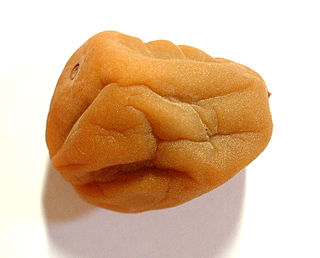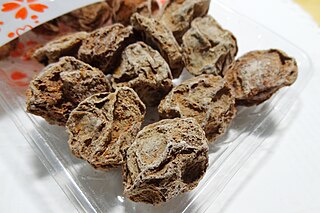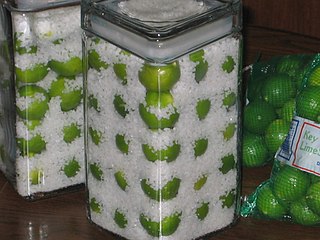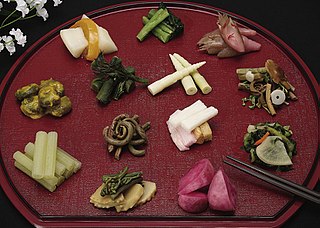
A plum is a fruit of some species in Prunus subg. Prunus. Dried plums are most often called prunes, though in the United States they may be just labeled as 'dried plums', especially during the 21st century.

A mooncake is a Chinese bakery product traditionally eaten during the Mid-Autumn Festival (中秋節). The festival is primarily about the harvest while a legend connects it to moon watching, and mooncakes are regarded as a delicacy. Mooncakes are offered between friends or on family gatherings while celebrating the festival. The Mid-Autumn Festival is widely regarded as one of the four most important Chinese festivals.

Umeboshi are pickled (brined) ume fruits common in Japan. The word umeboshi is often translated into English as 'salted Japanese plums', 'Japanese plums' or 'preserved plums'. Ume is a species of fruit-bearing tree in the genus Prunus, which is often called a "plum", but is actually more closely related to the apricot. Pickled ume which are not dried are called umezuke (梅漬け).

The cuisine of Hawaii incorporates five distinct styles of food, reflecting the diverse food history of settlement and immigration in the Hawaiian Islands.

Pickling is the process of preserving or extending the shelf life of food by either anaerobic fermentation in brine or immersion in vinegar. The pickling procedure typically affects the food's texture and flavor. The resulting food is called a pickle, or, if named, the name is prefaced with the word, 'pickled'. Foods that are pickled include vegetables, fruits, mushrooms, meats, fish, dairy and eggs.

Char siu bao is a Cantonese baozi (bun) filled with barbecue-flavored cha siu pork. They are served as a type of dim sum during yum cha and are sometimes sold in Chinese bakeries.

Shave ice or Hawaiian shave ice is an ice-based dessert made by shaving a block of ice and flavoring it with syrup and other sweet ingredients. On Hawai‘i Island, it is also referred to as "ice shave." In contrast, a snow cone, a similar American dessert, is made with crushed ice rather than shaved ice. The thin ice shavings of shave ice allow for the flavored syrups to be absorbed completely instead of sinking to the bottom. Hawaiian shave ice is derived from a similar ice-based dessert from Japan called kakigōri and thus involves similar production methods.

Dried shrimp are shrimp that have been sun-dried and shrunk to a thumbnail size. They are used in many East Asian, Southeast Asian and South Asian cuisines, imparting a unique umami taste. A handful of shrimp is generally used for dishes. The flavors of this ingredient are released when allowed to simmer.

Li hing mui, known as huamei in Mainland China, is salty dried Chinese plum. It has a strong, distinctive flavor and is often said to be an acquired taste, as it has a combination of sweet, sour, and salty taste. Originally from Guangdong Province, the name "li hing mui" means "traveling plum". "Li hing" is "traveling" and "mui" is "plum" in Cantonese. Li hung mui is called hoshiume in Japan, where the salty and sour umeboshi is also popular. Li hing mui, along with li hing powder, is extremely popular as a snack in Hawaii.
Saladitos are plums or apricots, which are dried, salted and which can also be sweetened with sugar and anise or coated in chili and lime. A common misconception is that saladitos and chamoy are the same thing; saladitos are the dried salted fruit, whereas chamoy is made from the leftover brine.

ChamoySpanish pronunciation:[t͡ʃaˈmoi̯] is a variety of savory sauces and condiments in Mexican cuisine made from pickled fruit. Chamoy may range from a liquid to a paste consistency, and typically its flavor is salty, sweet, sour, and spiced with chilies.

Pickled fruit refers to fruit that has been pickled. Pickling is the process of food preservation by either anaerobic fermentation in brine or immersion in vinegar. Many types of fruit are pickled. Some examples include peaches, apples, crabapples, pears, plums, grapes, currants, tomatoes and olives. Vinegar may also be prepared from fruit, such as apple cider vinegar.

Tsukemono are Japanese preserved vegetables. They are served with rice as an okazu, with drinks as an otsumami (snack), as an accompaniment to or garnish for meals, and as a course in the kaiseki portion of a Japanese tea ceremony.
Kiamoy, is a class of Filipino treats made with dried sour plums, prunes, or apricots preserved in brine and vinegar. They are sold covered in a powdery coating of an anise, li hing, salt, and sugar mixture called "kiamoy powder" or kiam-muy-hoon. They are characteristically bright red, orange, or light brown in color. They originate from Chinese Filipino immigrants and are derived from the li hing mui (旅行梅) treats of Chinese cuisine. The name is derived from Philippine Hokkien Chinese: 鹹梅; Pe̍h-ōe-jī: kiâm-muî; lit. 'salted plum'.












